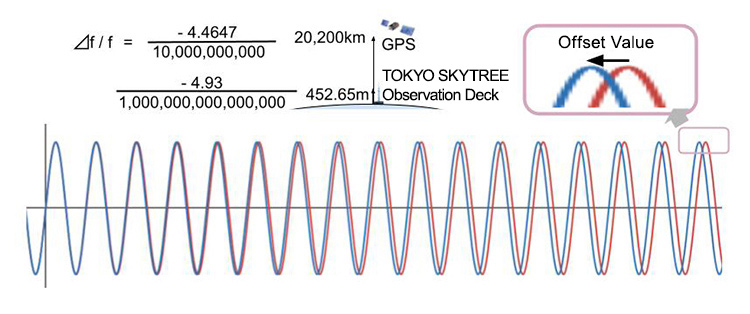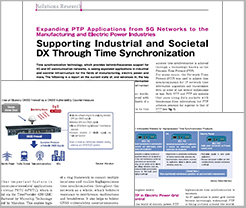Column
Time Progressing with a Speed Difference of Just 4.4647 Ten-Billionths!
In a previous article, I introduced an experiment conducted at TOKYO SKYTREE designed to test for relativistic effects. The oscillation frequencies of two optical lattice clocks, one at ground level and the other on the observation deck, were compared, revearling frequency difference of 21.18 hertz. This result confirmed the predicted disparity based on the theory of general relativity, caused by difference in gravitational potential due to the elevation difference.
The 21.18 hertz difference represents the absolute difference in frequency between the two measurement points. To express this as a fractional difference relative to the strontium-87 clock frequency, we can use the strontium-87 frequency as the denominator. Given that strontium-87 has an oscillation frequency of approximately 429 terahertz (specifically, 429,228,004,229,873 hertz), the fractional difference is calculated as 21.18 / 429,228,004,229,873, which is approximately 4.93x 10 ^-14, or about 4.93 parts per 100 trillion.
which can be written as 4.93E–14. The symbol E indicates an exponentiation of 10, so E-14 indicates "10 to the power of negative 14." This is a very small number; if the abovementioned elevation difference were larger, then this value would also be larger.
The Close Relationship Between GPS and Relativistic Effects
The "Frequency Plan" section of GPS specifications documentation includes a specific correction value to compensate for relativistic effects. This section starts by stating, "For GPS, the common frequency of 10.23 MHz is multiplied by a value to generate a carrier wave. For the carrier wave's center frequency, 10.23 MHz is multiplied by 154 for the L1 band to get 1575.42 MHz, and multiplied by 120 for the L2 band to get 1227.60 MHz." Regarding the correction value, the following explanation is provided:
“The nominal frequency --- as it appears to an observer on the ground --- is 10.23MHz. The SV carrier frequency and clock rates -- as they would appear to an observer located in the SV -- are offset to compensate for relativistic effects... The clock rates are offset by ⊿f/f = -4.4647E-10... is equal to 10.2299999954326MHz.”
(IS-GPS-200M)
In addition to the common frequency 10.23 MHz and the correction value –4.4647e–10, the document goes out of the way to state that the corrected frequency value is "equal to 10.2299999954326 MHz," shown down to the 13th decimal place— an indication of this value's importance.
The –4.4647E–10 correction value clearly describes the difference between the rate of time's passege on the satellite (space vehicle, or SV) in orbit and on the Earth's surface.
If we use the figure of 4.93 over 100 trillion we calculated based on the TOKYO SKYTREE experiment and compare it with the above value, the resulting value for a GPS satellite is 4.46 over 10 billion. Both are very small figures, yet there is a 10,000-fold difference between them.
 A visual comparison of the frequencies from the same oscillator on the Earth's surface (blue line) and aboard a satellite (red line). A negative offset value is used for GNSS satellites in order to correct for the disparity caused by relativistic effects (⊿f/f).
A visual comparison of the frequencies from the same oscillator on the Earth's surface (blue line) and aboard a satellite (red line). A negative offset value is used for GNSS satellites in order to correct for the disparity caused by relativistic effects (⊿f/f).
Changes in a satellite's orbit necessitate corresponding adjustments to the relativistic correction value. Japan's Quasi-Zenith Satellite System (QZSS), known as "Michibiki", maintains signal compatibility with GPS. Three of the four QZSS satellites operate with a maximum orbital altitude of approximately 40,000 kilometers (QZS-3 is a geostationary satellite and thus an exception). Their specifications documentation addresses these correction amounts as follows:
“However, the nominal frequency(f0)=10.23MHz is offset by the ⊿f/f0 = -5.399E-10 to compensate for frequency difference between the ground surface and satellite orbit due to the relativistic effects. For this reason ... the L1 band signal is offset by -0.8506 Hz (nominal).”
(IS-QZSS-PNT)
In contrast to the 4.46E-10 value for GPS, Michibiki has a value of 5.40E-10. Although this is a noticeable difference, it is not such a significant one when the major altitude difference is taken into consideration.
 The degree of special relativistic effects (purple arrows) resulting from high-speed travel and general relativistic effects (pink arrows) resulting from high altitude (and thus low gravitational forces) are both factored in, and the resulting divergence is used to determine the offset value. QZSS satellites operate at a higher altitude than GPS satellites, but the former use slower orbital travel speeds, meaning the purple-arrow effects are smaller and the pink-arrow effects larger. The result is a larger final offset.
The degree of special relativistic effects (purple arrows) resulting from high-speed travel and general relativistic effects (pink arrows) resulting from high altitude (and thus low gravitational forces) are both factored in, and the resulting divergence is used to determine the offset value. QZSS satellites operate at a higher altitude than GPS satellites, but the former use slower orbital travel speeds, meaning the purple-arrow effects are smaller and the pink-arrow effects larger. The result is a larger final offset.
Is GPS Possible, without Relativistic Correction?
Could a GPS system have been designed without using correction values? While theoretically possible—albeit with significantly more complex calculations, given that the relativistic effects are well understood—such a system would have presented substantial operational challenges. Specifically, managing disparate time series for Earth-based receivers and satellites experiencing different rates of time's passage would have made maintaining long-term accuracy and consistency extremely difficult.
Consider, for example, that the "leap second" has been introduced 27 times in the past to synchronize Coordinated Universal Time (UTC) with Universal Time (UT1), the latter being based on the Earth's rotation. Due to the complexities and operational burden associated with implementing leap seconds, their application has been suspended. Had GPS been designed without relativistic corrections, similar, but far more frequent, adjustments would have been necessary. This would likely have rendered GPS impractical for widespread use.
In contrast, the current approach of using Earth-based atomic clocks as standards and adjusting satellite clocks accordingly is a far more simple and effective solution. Without this approach, GPS would not have achieved its current widespread adoption, and Japan's Michibiki system, operating at a different orbital altitude while maintaining compatibility and interoperability with GPS, would not have been realized.
On the Moon, where gravity is approximately one-sixth that of Earth's, a day passes approximately 57.5 microseconds faster. Expressed as a fractional frequency offset, this corresponds to 6.655E-9, significantly larger than the relativistic corrections applied to Earth-orbiting navigation satellites. However, with precise knowledge of these values, engineers could design a lunar PNT system.
Writer introduction

Mr. Mitsunari Kita Science and technology writer
Born in Ishikawa Prefecture in 1964. Based on his experience in covering industrial technology, cutting-edge technology, and space development, he is passionate about unraveling and conveying difficult topics in an interesting way to people of all ages, from children to senior citizens. From 2009 to 2014, he was a member of the editorial board of "JAXA's," the official magazine of the Japan Aerospace Exploration Agency. Author and co-author of the following books: 『あなたにもミエル化? ~世間のなりたちを工学の視点から~』(幻冬舎mc)、『私たちの「はやぶさ」その時管制室で、彼らは何を思い、どう動いたか』(毎日新聞社)、『東京大学第二工学部70周年記念誌 工学の曙を支えた技術者達』(東京大学生産技術研究所) etc.,
* All registered trademarks used herein are the property of their respective owners.
Pick up
Column
FURUNO Column
Column by Mr. Mitsunari Kita (Science and technology writer)
-
FURUNO ELECTRIC Joins Experts From Around the World on a Norwegian Island for Jammertest 2024

-
Unraveling the Mysteries of Venus Based on "Occultation"

-
Atoms as the Basis for Measuring Both Fleeting Moments and Near-Eternities

-
Time Progressing with a Speed Difference of Just 4.4647 Ten-Billionths!

-
Critters Who Revitalize Forests Through the Spreading of Food Caches

-
Small But Significant Variances in Gravity and Time (Part Two of Two)

-
Small But Significant Variances in Gravity and Time (Part One of Two)

-
Why the GT-100 Time-synchronization GNSS Receiver Module is Like Fragrant Soup Curry

-
What Rainbows Can Teach Us About Dual-Band GNSS

-
The Amazing Things That Are Possible With Just a Clock

-
When Subterranean Earth Meets Outer Space

-
Using the TB-1 and GT-100 at a "Multipath Dojo" in the Major Metropolis of Osaka

-
The Disaster-struck Field Time Sync Generator TB-1: True Performance Revealed Through a Lightning Strike

-
Knowing the "Now" of Our Earth Through GNSS

-
The Reason GPS Counts Time in 1.5-second Intervals

-
Similarities Between "On My Count!," the 117 Notification System, and GPS

-
Reliable Clocks Help Us Find a Silver of the Clouds

-
Why Time Synchronization is Vital for Criminal Investigations, Seismograph Measurements and Solar Wind Observation

-
What Was "Cesium" About Cesium Akina?

-
Updating Analog Broadcasting with GNSS Time Synchronization Technology

-
The Long History of One Second (Part II)

-
The Long History of One Second (Part I)

-
A Solo Journey - Three-liter Microsatellite Mission Support via GPS (GNSS) and Satellite Communication -

-
A Solo Journey - The GPS (GNSS) Tracking System That Helped Kenichi Horie Cross the Pacific -

-
The Day After a Superflare - Effects on power and wireless communication infrastructures -





